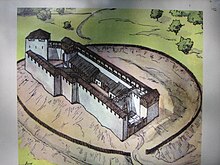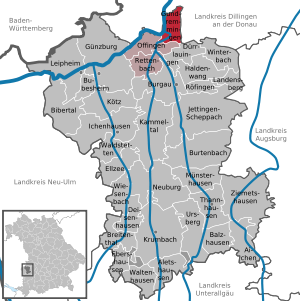Gundremmingen
| coat of arms | Germany map | |
|---|---|---|

|
Coordinates: 48 ° 30 ' N , 10 ° 24' E |
|
| Basic data | ||
| State : | Bavaria | |
| Administrative region : | Swabia | |
| County : | Gunzburg | |
| Management Community : | Offingen | |
| Height : | 437 m above sea level NHN | |
| Area : | 10.83 km 2 | |
| Residents: | 1349 (Dec. 31, 2019) | |
| Population density : | 125 inhabitants per km 2 | |
| Postal code : | 89355 | |
| Area code : | 08224 | |
| License plate : | GZ, KRU | |
| Community key : | 09 7 74 136 | |
| Address of the municipal administration: |
Rathausplatz 1 89355 Gundremmingen |
|
| Website : | ||
| Mayor : | Tobias Bühler ( CSU ) | |
| Location of the community of Gundremmingen in the district of Günzburg | ||
Gundremmingen is a municipality in the Swabian district of Günzburg .
geography
The place Gundremmingen is located in the Donauried near the confluence of the Mindel (right tributary) into the Danube .
history

The remains of a Roman fort , the so-called Bürgle , have been found in the area of the municipality . It was built south of the Danube to secure the border after the Alemanni succeeded in overrun the northern Roman border marked by the Limes in the years 213, 233 and 259/260 . The Bürgle was part of the late Roman border security in Raetia and belonged to the Danube-Iller-Rhein-Limes . It was destroyed around 380 AD.
The place was founded by a Germanic clan, whose leader was probably "Guntram". A first documentary mention can be found in the Codex Eberhardi from the 12th century. Around 800 AD "Hiltwin" then transferred properties in "Guntramingen" with six unfree people to the Fulda Monastery .
The village was rural for centuries. In the Peasants' War in 1525, several residents joined the Leipheimer Haufen .
Gundremmingen belonged to the rule of Aislingen within the bishopric of Augsburg and fell to Bavaria with the Reichsdeputationshauptschluss from 1803.
On April 1, 1822, Ignaz Lindl , former pastor of the parish of Gundremmingen, founded the Sarata colony in Bessarabia . A good number of the 70 founding families had emigrated from Gundremmingen.
Population development
Between 1988 and 2018 the municipality grew from 1,151 to 1,326 by 175 inhabitants or 15.2%.
politics
The community is a member of the Offingen administrative community .
City council and mayor
The municipal council has twelve members. Based on the election on March 15, 2020, it is composed as follows:
- Together for Gundremmingen: 4 seats (35.1%)
- CSU : 4 seats (31.3%)
- Free constituency / Independent constituency: 2 seats (17.5%)
- Junge Union : 2 seats (16.0%)
In the local elections in 2002 and 2008, the CSU had eight seats and the Free Community of Voters / Independent Community of voters four seats. In the 2014 local elections, the distribution of seats in the local council was as follows: 5 CSU, 4 GFG and 3 free voters.
Mayor was Wolfgang Mayer (FWG / UWG) from 1996 to April 2014. His successor has been Tobias Bühler (CSU) since May 2014; he was confirmed in office on March 15, 2020 for a further six years and is an additional member of the municipal council.
coat of arms
|
Blazon : "A golden atom symbol in blue over a golden battlement wall with a gate tower in the shield base."
The wall with the gate tower indicates the Roman archaeological site of Bürgle , east of Gundremmingen . The atom symbol in the coat of arms refers to the local nuclear power plant . |
|
Culture and sights
music
Since it was re-established in 1985, the Gundremmingen brass band has developed into a good middle school orchestra and has also become an integral part of the community's cultural life. In addition to appearances at festivals or events inside and outside the municipality, a spring concert has been held every year since 1988 and, as a member of the Allgäu-Swabian Music Association, the band regularly takes part in their rating games. The "Joe Gleixner Bigband" has been part of the music association since 2005.
Architectural monuments
education
- primary school
- Branch of Volkshochschule Günzburg
Nuclear power plant
The structure of the place changed with the construction of the local nuclear power plant , which was then the largest European power generator of this type in terms of output. Originally, this nuclear power plant was to be built in Bertoldsheim , a small town on the Danube between Donauwörth and Neuburg / Danube. As a result of protests by the city of Nuremberg , which has wells for its long-distance water supply there, these plans were abandoned and the new location in Gundremmingen in Swabia was chosen. A peasant protest that flared up there died out within a few months after the prospect of financial advantages. After four years of construction, electrical energy was fed into the network for the first time on November 12, 1966 .
Unit A was in operation until an accident in 1977 in which the reactor building was radioactively contaminated over a large area. It was the first and so far only major accident involving a nuclear power plant with a total loss. This block A has been dismantled since 1983. The dismantling should be completed by 2005. According to the operator, the total dismantled mass is around 8,200 tons. A large part of this is recycled using processes developed in Gundremmingen. The mass fraction that actually has to be disposed of because of radioactivity is around ten percent.
In 1976, as part of the implementation of long-term plans by RWE and as a result of the oil crisis previously experienced , the construction of the two 1,344 megawatt blocks B and C began. They have been supplying energy to the grid since 1984, currently producing around 20 terawatt hours (20 billion kilowatt hours) per year. Measured against the demand for electrical energy in Bavaria, the current output is sufficient to cover around 30 percent of this demand. The two reactors are together the largest nuclear power plant in Germany (as of December 2017) - They are among 75 percent of residents in Essen RWE and 25 per cent E.ON . As a result of the nuclear phase-out, Unit B was taken off the grid on December 31, 2017, so that only Unit C is still in operation.
As part of the nuclear phase-out, the transport of spent fuel elements for reprocessing was prohibited on July 1, 2005. The operators therefore had to set up interim storage facilities at the power plant locations. The interim storage facility in Gundremmingen allows the storage of 192 castors . Construction began in August 2004. Several lawsuits against the nuclear license were rejected by the Bavarian Administrative Court in Munich on January 2, 2006. A complaint against the non-admission of the appeal was rejected by the Federal Administrative Court in August 2006.
Personalities
Pastor Richard Harlacher (born January 16, 1935) was made an honorary citizen on January 18, 2015; he has been working in the village for 46 years.
Web links
Individual evidence
- ↑ "Data 2" sheet, Statistical Report A1200C 202041 Population of the municipalities, districts and administrative districts 1st quarter 2020 (population based on the 2011 census) ( help ).
- ↑ Town Hall Municipal Council. Community of Gundremmingen, accessed on August 9, 2020 .
- ^ Entry on the coat of arms of Gundremmingen in the database of the House of Bavarian History
- ^ Honorary citizenship for Richard Harlacher




